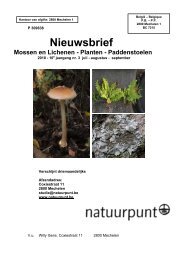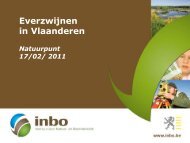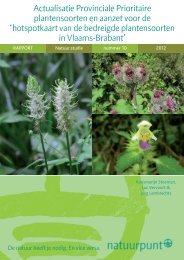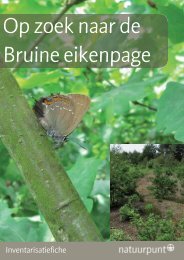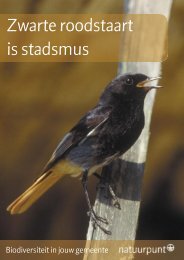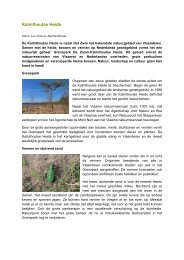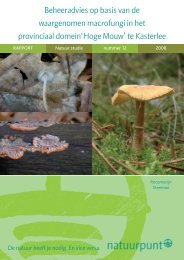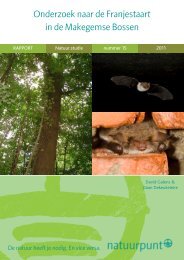Libellen in de Wellemeersen - Natuurpunt
Libellen in de Wellemeersen - Natuurpunt
Libellen in de Wellemeersen - Natuurpunt
You also want an ePaper? Increase the reach of your titles
YUMPU automatically turns print PDFs into web optimized ePapers that Google loves.
SUMMARY<br />
Chapter 1 is an acqua<strong>in</strong>tance with “De <strong>Wellemeersen</strong>”, a valuable nature reserve (109 ha) situated <strong>in</strong> Eastern Flan<strong>de</strong>rs<br />
(Belgium) on the left bank of the river Den<strong>de</strong>r.<br />
Its orig<strong>in</strong>, soil, natural and artificial bor<strong>de</strong>rs, geomorphical, hydrographical and hydrological features are represented.<br />
The <strong>in</strong>fluence of man on the area throughout the years is discussed, as well as the vegetation types and fauna found <strong>in</strong> the<br />
reserve. Some of these features are represented more specifically <strong>in</strong> the next chapters.<br />
Chapter 2 discusses the migration of dragonflies. The consi<strong>de</strong>red area is <strong>de</strong>limited by steep railroad slopes <strong>in</strong> the south,<br />
southwest and west, the river Den<strong>de</strong>r <strong>in</strong> the east and the highway Brussels-Ostend <strong>in</strong> the North. All of these limits might serve<br />
as artificial pathways for dragonfly distribution. So, the whole area might act as a life trap for any migrat<strong>in</strong>g dragonfly.<br />
Another way of reach<strong>in</strong>g the area is an acci<strong>de</strong>ntal importation by boat, tra<strong>in</strong> or any other conveyance.<br />
In chapter 3 a <strong>de</strong>scription of some specific dragonfly biotopes is given. The ol<strong>de</strong>st pools <strong>in</strong> the transgression area of the<br />
Den<strong>de</strong>r, the three sand pools, created <strong>in</strong> the middle of the 19 th century as a consequence of soil-extraction for rais<strong>in</strong>g the<br />
railway slopes; the larger Gates pond, dug out between 1953-1954 for rais<strong>in</strong>g the local highway section; the bomb holes<br />
created <strong>in</strong> the area after heavy bomb<strong>in</strong>g on the railway station of Den<strong>de</strong>rleeuw <strong>in</strong> 1944; the fish<strong>in</strong>g pools dug out by owners<br />
between the early sixties and the middle of the seventies of which some today are still private property; the humid, swampy<br />
meadows - all of these are man-shaped biotopes that throughout the years were colonized by dragonflies.<br />
Chapter 4 aims to stimulate future research <strong>in</strong> the reserve our elsewhere. Gui<strong>de</strong>l<strong>in</strong>es for i<strong>de</strong>ntification, captur<strong>in</strong>g and collec-<br />
t<strong>in</strong>g dragonflies an their larvae are given.<br />
In chapter 5 the methodology of the data-collection dur<strong>in</strong>g the period 1996-2007 is discussed. The vast majority of records<br />
perta<strong>in</strong>s to observations by sight. All dubious observations or records of rare species were double checked. The data used for<br />
the distribution maps <strong>in</strong> the species accounts is <strong>de</strong>scribed. The second part of the chapter discusses the process<strong>in</strong>g of the 1840<br />
records that were noted dur<strong>in</strong>g the period 1996-2007. 36 species are on record of which two are very disputable and were not<br />
consi<strong>de</strong>red further. Of the 34 rema<strong>in</strong><strong>in</strong>g species, 23 were found to be true <strong>in</strong>habitants of the area. N<strong>in</strong>e species were<br />
consi<strong>de</strong>red to be dwell<strong>in</strong>g and for two species the collected data rema<strong>in</strong> <strong>de</strong>ficient. F<strong>in</strong>ally the abundance and distribution of<br />
the true <strong>in</strong>habitants <strong>in</strong> the reserve are discussed as well as the Red list-category <strong>in</strong> Flan<strong>de</strong>rs of all species. All true <strong>in</strong>habitants<br />
are Red listed as “Not threatened”.<br />
Chapter 6 is a gui<strong>de</strong> to the species accounts texts. The habitat, life history, ecology , behaviour, range, conservation, status<br />
and distribution <strong>in</strong> the nature reserve is discussed for the 36 dragonfly species that were observed until today.<br />
Dot maps of their distribution <strong>in</strong> two periods are provi<strong>de</strong>d. The Red list category <strong>in</strong> Flan<strong>de</strong>rs of the species is given. The flight<br />
season of the commoner species is illustrated by a histogram of records of adults <strong>in</strong> ten days categories. Each species account<br />
<strong>in</strong>clu<strong>de</strong>s an English summary, highlight<strong>in</strong>g the status and habitat of the species consi<strong>de</strong>red.<br />
98<br />
Summary



